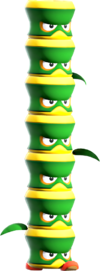Gamboo: Difference between revisions
No edit summary |
|||
| Line 5: | Line 5: | ||
}} | }} | ||
'''Gamboos'''<ref name="jparticle">[https://topics.nintendo.co.jp/article/f6d2505a-dd79-410d-b350-b2b2036213f0]</ref> are bamboo-like enemies of various colors often seen in stacks that were introduced in ''[[Super Mario Bros. Wonder]]''. Green and purple variants were introduced in [[The Midway Trial: Hop to It]], with metallic ones being first shown in [[Missile Meg Mayhem]]. Stacks of Gamboo often hide in the ground and pop up when the player gets near. These enemies can be thrown when stomped; capable of defeating other enemies the same as a [[Shell]], but functioning differently as they instead bounce off the ground a few times before losing momentum. | '''Gamboos'''<ref name="jparticle">[https://topics.nintendo.co.jp/article/f6d2505a-dd79-410d-b350-b2b2036213f0]</ref> are bamboo-like enemies of various colors often seen in stacks that were introduced in ''[[Super Mario Bros. Wonder]]''. Green and purple variants were introduced in [[The Midway Trial: Hop to It]], with metallic ones being first shown in [[Missile Meg Mayhem]]. Stacks of Gamboo often hide in the ground and pop up when the player gets near. These enemies can be thrown when stomped; capable of defeating other enemies the same as a [[Shell]], but functioning differently as they instead bounce off the ground a few times before losing momentum. Their name is possibly an anagram of "[[Goomba]]" made to sound like "bamboo". | ||
Metallic Gamboos are immune to [[Fire Mario]]'s fireballs and can interact with electricity in the level [[High-Voltage Gauntlet]]. In its electrical state, the player cannot touch them (unless using an attack in either [[Drill Mario|Drill Form]] or [[Elephant Mario|Elephant Form]]) without taking damage, even if the enemy is in its stomped state. | Metallic Gamboos are immune to [[Fire Mario]]'s fireballs and can interact with electricity in the level [[High-Voltage Gauntlet]]. In its electrical state, the player cannot touch them (unless using an attack in either [[Drill Mario|Drill Form]] or [[Elephant Mario|Elephant Form]]) without taking damage, even if the enemy is in its stomped state. | ||
Revision as of 03:06, January 26, 2024
| Gamboo | |||
|---|---|---|---|
 Rendered game model of Gamboo | |||
| First appearance | Super Mario Bros. Wonder (2023) | ||
| |||
Gamboos[1] are bamboo-like enemies of various colors often seen in stacks that were introduced in Super Mario Bros. Wonder. Green and purple variants were introduced in The Midway Trial: Hop to It, with metallic ones being first shown in Missile Meg Mayhem. Stacks of Gamboo often hide in the ground and pop up when the player gets near. These enemies can be thrown when stomped; capable of defeating other enemies the same as a Shell, but functioning differently as they instead bounce off the ground a few times before losing momentum. Their name is possibly an anagram of "Goomba" made to sound like "bamboo".
Metallic Gamboos are immune to Fire Mario's fireballs and can interact with electricity in the level High-Voltage Gauntlet. In its electrical state, the player cannot touch them (unless using an attack in either Drill Form or Elephant Form) without taking damage, even if the enemy is in its stomped state.
Silver and purple Gamboos turn around when facing a ledge, while its green and golden counterparts fall off of edges. Some can also be seen dancing in place during different Wonder Effects.
Gallery
- Gold Takebo.jpg
A golden Gamboo
Additional names
Internal names
| Game | File | Name | Meaning
|
|---|---|---|---|
| Super Mario Bros. Wonder | G:/romfs/Model/EnemyTakebo.bfres.zs | Takebo | Japanese name |
Names in other languages
| Language | Name | Meaning | Notes |
|---|---|---|---|
| Japanese | タケボー[2] Takebō |
Portmanteau of「 |


